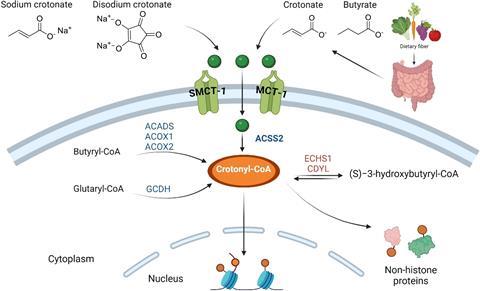
Lysine crotonylation is an understudied yet very interesting post-translational modification which has great medical potential, a group from Utrecht University reports in ChemBioChem.
Post-translational modifications (PTMs) are essential parts of the biochemistry of (human) cells, with functions like folding, stability, and interaction with other cell components. One type of PTMs are the lysine short chain acylations (SCA), which at presentare among the most studied. However, one recently discovered SCA has been very much underexplored, according to Marinda Westerveld, Rita Petracca and colleagues from Utrecht University: lysine crotonylation (Kcr). In a review, they highlight ‘Kcr’s potential and identif[y] gaps needing further investigation’.
‘The crotonyl group is a functional group that is pretty different to other moieties’, says Assistant Professor Rita Petracca. ‘From an organic chemistry point of view, crotonyl opens doors for chemical intervention which you don’t normally see.’ Another reason that Kcr stands out among other acylations, is that it is largely unexplored. ‘There are many articles coming up that make clear that crotonylation is involved in many cancers, but there aren’t many studies that specifically target this PTM, probably because there is a lack of chemical tools to study this modification.’
Gaps
‘On a mechanistic level, Kcr influences gene expression in a similar way and to a greater degree than lysine acetylation [Kac, ed.]’, the authors write in their review. ‘To date, there are reports demonstrating the involvement of both histone and non-histone crotonylation in numerous diseases of relevant social impact, such as AKI, AD, depression, HIV latency, cancer, cardiovascular diseases, and liver fibrosis.’
Despite the studies done on Kcr, there are still gaps in our knowledge of this PTM, Petracca says. ‘The main gap is related to the regulation of this modification in the cell. We don’t really know exactly from where the crotonyl group comes. Is it a metabolite intermediate, or could it also enter the body via our diet?’ Another unanswered question is which enzymes regulate Kcr. ‘In certain types of cancer there is either an augmented or diminished state of crotonyl. Why is that and how does it work?’
Photochemistry
‘A reason that people did not study this PTM in depth could be because crotonyl is a tricky group, chemically speaking’, Petracca continues. ‘It doesn’t respond to ordinary chemistry, but we found out that photochemistry helps a lot.’
Petracca, who has a background in organic and photochemistry but now works mostly as a chemical biologist, designs activity- or reactivity-based chemical probes to catch PTMs in the act and to ‘fish’ for specific groups in a complex proteome. For this, she uses light and photoactivated chemistry to ligate her probes to the proteins that have a specific PTM.
‘Since I worked on photochemical reactions before, I was very curious to see if this group would react with those’, Petracca explains. ‘It turns out that it works very well, and we have an article in the pipeline that extensively explores the reactions. As far as I know, this is the only photochemical reaction that works with it, which is probably the reason why the research has been limited.’
Fish
The upcoming article will also deal with proteins that are crotonylated. Petracca: ‘I try to fish for these proteins that have one or more crotonylation sites. This way, you can identify new markers for cancers and see which proteins are related.’ This is important, because though it is known that this modification is found in cancer, where it occurs and why the crotonylation-rate suddenly increases is still veiled in obscurity.
‘Because the discovery of crotonylation is fairly recent, it is pretty hard to “sell” it to people’, Petracca says. ‘In biology, crotonylation is very well known, but in chemical biology, many have never even heard about it, which I find bizarre.’ There should be more people working on Kcr, Petracca declares. ‘As a chemist I can do some biology, but there are many more interesting aspects concerning crotonylation that could be investigated by different points of view. I really believe this modification has great medical potential.’
Westerveld, M. et al. (2024) ChemBioChem e202400639, DOI: 10.1002/cbic.202400639











Nog geen opmerkingen